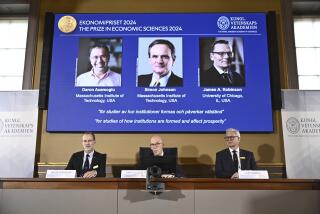Caltech economist nets MacArthur genius grant
A Caltech researcher who fused economics and neuroscience to make sense of human decisions that often don’t make cents has won the MacArthur genius grant.
Colin Camerer came to Caltech in 1994 with an MBA in quantitative studies and a doctorate in decision theory from the University of Chicago’s business school, a place he described as “the temple of beliefs in highly rational people who make really good decisions and take into account the future.”
“I just thought that was a useful caricature, but not the right model of human nature,” Camerer said. “That’s what got me into behavioral economics.”
Veering from the notoriously conservative orthodoxy of economics at the University of Chicago to study human behavior may seem a risky career turn, but things got weirder when Caltech opened its brain imaging lab in 2003.
Actual neuroscientists might have chased away a business school graduate who wanted to put people under the magnet to see what went on when they played obscure game theory experiments.
“Caltech is a very adventurous place,” Camerer said. “Part of the culture is that we tolerate people doing things that seem impossible, and also synthesizing and borrowing ideas across very kooky and unusual boundaries.” The lab welcomed Camerer.
“I improvised,” said Camerer, who is the Robert Kirby Professor of Behavioral Finance and Economics. “I have no formal training in neuroscience. I have some really smart people who work with me who are my tutors. Neuroscientists here who are very accomplished spend a lot of time answering our stupid questions.”
Those questions have led to pioneering research into how the brain works while making decisions about such things as whether to participate in an economic “bubble,” when prices accelerate. Last week, Camerer published a study that suggests participants in a bubble – such as the increase in housing prices – are not reckless or rash, but have a highly developed “theory of mind” that allows them to consider what others would do, and use that to guide their risky decisions.
The study was not published in the major economics journals, but in Neuron, a highly regarded neuroscience journal. That, said Camerer, was validation enough.
“The arbiters I care about are the referees of the journals and the people who cite papers,” Camerer said. “If we could not get papers published in the serious neuroscience journals, I would feel that we really failed -- maybe the neuroscientists are right -- we aren’t good enough to do the work under their terms.”
Still, Camerer acknowledged that the fusion of economics with neuroscience has not been without debate. Plenty of economists believe the neural minutiae of the brain won’t add much of value to knowledge of economics, while some neuroscientists question whether this business school graduate is out on a limb.
“It is true that the major complaint we get from neuroscientists across the board is we don’t know enough about very basic brain neurochemistry to be able to talk about something like willpower in the brain,” Camerer said. “In some ways I think they’re right, but willpower is a really important thing to understand, and I’m not going to wait 30 years to get a phone call from a molecular biologist who says, ‘OK, now we can help you figure out willpower.’ Why not start now?”
The MacArthur Foundation apparently agreed. It noted that Camerer was “an early architect of behavioral game theory” who “continues to push the boundaries of economic methodology as a leader of the emerging field of neuroeconomics.”
Camerer plans to use some of the grant to buy his wife a fancy watch, “because she’s always late,” he says. “She may still be late, but now she has less of an excuse.”
But Camerer also hopes to create an independent and lasting source of research funding, for times when he might not want to convince a panel of experts to write a grant.
Sometimes, Camerer said, “you just want to plunge in and try it first.”







